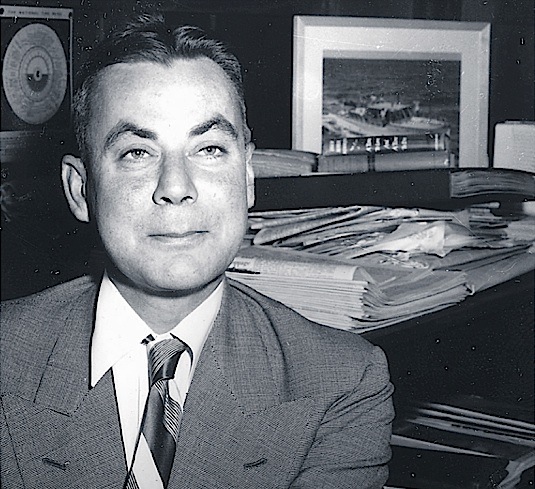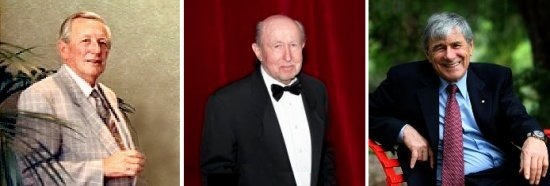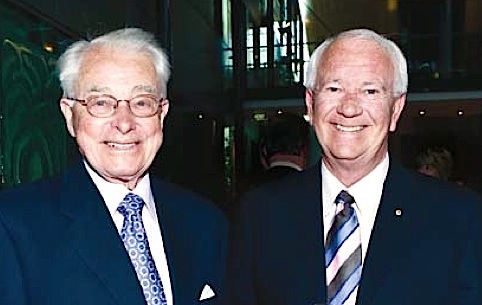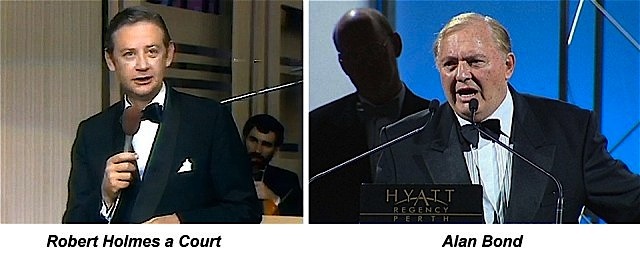It’s interesting how allegiances can change with time. For example, Jim Cruthers’ licence application beat Rupert Murdoch’s Western Television bid to operate the first television station in WA, which was won by TVW Limited. Yet Cruthers became personal adviser to Rupert Murdoch on retiring as Chairman and Managing Director of TVW Enterprises in 1981. Sir James was not the only TVW manager to join Murdoch, as Max Bostock ran Network Ten and Bill McKenzie ran ATV Channel 0 (later 10) whilst owned by News Investments Pty Limited. The shift in allegiance was motivated by the takeover of TVW Enterprises by Robert Holmes à Court.

Some of the key TVW personnel and Board at the retirement dinner
for Frank Moss in 1979
Back row, from left: D’arcy Biesot, Darcy Farrell, Greg Byrne, Dick Ashton, Kevin Bicknell, Max Bostock, Syd Donovan, Rolf Lindsey, Bernie Roddy, Wally Staniforth, John Hunn, Jan Vermazen, Alf Binks.
Front row: Bill McKenzie, Joe Sweeney, Jim Cruthers, Frank Moss, Jack Donovan, Ken Kemp, Charles Hugall.
It was Cruthers’ boss at WA Newspapers, James Edward Macartney (1911-1977), who started the whole TVW ball rolling… yet also jumped ship, when on leaving the newspaper company in May 1969, he took up a position as a consultant to STW Channel 9, TVW’s competition.

After former TVW co-founder Brian Treasure retired from the station in December 1975, his business dealings involved working for Nine network boss Kerry Packer and establishing Perth’s first commercial FM radio station, 96FM, with funding from Kerry Stokes and Jack Bendat. This team also created West Coast Telecasters, the successful applicant for the NEW Channel 10 licence in Perth. Though the company was sold to Frank Lowy’s Northern Star Holdings before they went to air on Friday May 20, 1988, as a result of a change in government policy. A number of key TVW management and staff were involved with the new channel. These included Bill McKenzie (Managing Director), Stuart Joynt (founding News Director), Marion Leyer (Director of Production) and Glenys Gill (Program Manager).

Many TVW staff jumped ship to STW after Perth’s second commercial station was established in 1965. These included, Lloyd Lawson, Audrey Barnaby, Ernie Taylor, Vic Kitney, George Baker, Colin Gorie, Bob Penno, Cedric Woods, the Davies twins, Geoff Waldock, Keith Bales, John Shepherd, Olive Barrett (nee Shearer), the Cox brothers, Vic Gaidelevicius, Liz Kirkham, Eric Walters, Russell Sage, Ray Sinclair, Steele Stacey, Frank Bird, Chas Broughton, Peter Waltham, Russell Goodrick, Greg Pearce, Terry Willesee, John Hudson, Phil Booth, Errol Considine, Brian Coulter, Harry Kelly, Dexter Crowell, Bob Goodall, Pedro Dunn, Peter Finn, Tod Johnston, Stuart Joynt, Terry Spence, Ric Stone, and many more. Whilst others trod the other route to Seven, including, Jeff Newman, Peter Dean, Jenny Seaton (nee Clemesha), Ron Berryman, John Crilly, Bob Finkle, Michael Goodall, Ernie Taylor and Vic Kitney returning, Tom Warne and Chris Gore, to name a few.
The fortunes of TVW under Sir James Cruthers were outstanding, but unfortunately the cash rich company attracted corporate raiders and succumb to the giddy era of empire manipulation where often valued assets were stripped for other purposes. TVW was proud of their museum and early family work environment, but all this was to change after considerable growth and take-overs, firstly with Robert Holmes à Court, briefly with Alan Bond and finally ending in bankruptcy after the failed ventures of Christopher Skase. It was one of Cruthers protégés Kevin Campbell who helped restructure the company and float it on the stock exchange, to eventually end up today, as part of Kerry Stokes empire, who himself was a protégés of Brian Treasure.

STW for a time was also embroiled in a massive corporate adventure, with Alan Bond’s audacious takeover of the Nine network, with his short lived media empire crumbling two years after the October 1987 stock market crash. Bond also controlled WA Newspapers before being declared bankrupt in 1992. WA Newspapers was restructured and floated on the stock exchange as West Australian Newspapers Holdings the same year. In December 2008, Kerry Stokes became chairman of the reformed company, following a power struggle with the previous board.

Now things have gone full circle, except in this case the Seven Network interests now control WA Newspapers.
Kerry Stokes speech at 2009 TVW Corporate Function
WA TV History
The executive chairman of the Seven Network Mr Kerry Stokes delivered a speech on Friday 16th October 2009, at the TVW Corporate Function to mark the 50th anniversary of television in Western Australia. Mr Stokes spoke about the TVW staff, both past and present, who have contributed so much to broadcasting in WA, of whom many have gone further in the east and other networks, after gaining their training in Perth.
Time Line for Period of Turmoil for TVW and WA Newspapers
- 1969 – 27th of April: The first issue of the Independent, a Perth Sunday newspaper; published to December 2nd 1970 under that title and then 3rd January 1971 to 24-25 May1986 as Sunday Independent.
- 1969 – May: The West Australian was a locally-edited and owned daily newspaper run by the publicly-listed company West Australian Newspapers Ltd from the 1920s, when the managing director of West Australian Newspapers, J.E.Macartney left the company in May 1969.
- 1969 – The Herald and Weekly Times Limited bought The West Australian in 1969, but sold it to Robert Holmes à Court in 1987 as part of the News Limited takeover of H&WT.
- 1970 - Robert Holmes à Court gains control of WA Worsted & Woollen Mills
- 1971 - TVW Enterprises purchased the Adelaide station, SAS10, now SAS7.
- 1973 - Robert Holmes à Court’s WA Worsted & Woollen gains control of Bell Bros and gains control of Albany Advertiser, Katanning Great Southern Herald and radio station 6VA.
- 1973 – City Theatres taken over by a consortium consisting of local television companies TVW Ltd, Swan Television and Michael Edgley
- 1975 – City Theatres launched the Academy ‘twins’ cinemas, under the wing of the vast Entertainment Centre.
- 1976 – 21st October: Western Australian Worsted and Woollen Mills Limited renamed Bell Group Limited.
- 1978 – August 1978: TVW Ltd buys out the other City Theatres partners and soon after vacated the Royal Theatre.
- 1979 – Decisions by the Federal Government to relax Electronic Media ownership rules lead to a flurry in takeover activity in the ownership of Australian Television Stations.
- 1979 – Robert Holmes à Court appointed to the TVW board in December 1979
- 1980 – Perth’s Cinema City developed by TVW and served the community for 27 years from 6th November 1980 to 17th October 2007, being taken over by Hoyts in 1988.
- 1980 – 8th November: Robert Holmes à Court launched the Western Mail, a Saturday newspaper, to challenge the Herald & Weekly Times (H&WT) which owned the West Australian.
- 1981 – Sir James Cruthers retired as Chairman and Managing Director of TVW Enterprises in 1981 and became Chairman of the Australian Film Commission.
- 1981 – August: The boards of TVW Enterprises Ltd and Western Mail Ltd, which were both chaired by Robert Holmes à Court, appointed the Melbourne broker Potter Partners to advise on a move towards a merger. At that time, TVW already owner 30% of Western Mail, as did the transport and media company Bell Group Ltd, of which Robert Holmes à Court was also the chairman. Bell Group in turn, held 22% of TVW. At that point, TVW was capitalised on the market at $36.7 million, whilst Western Mail was capitalised at $12.2 million. This was reported by the West Australian newspaper on Friday August 7, 1981.
- 1981 Shortly after the Holmes à Court takeover most of the senior executives of TVW started leaving: Howard Shephard (1981), Joseph Sweeney (1981), Max Bostock (1982), Bill McKenzie (1982), Russel Perry (1983), J Barrey Williams (1983), Alf Binks (1983), Ken Kemp (1983), Marion Leyer (1985), Bob Page (1985).
- 1982 - TVW (and SAS) no longer a public company after purchase by Perth based businessman Robert Holmes à Court’s Bell Group.
- 1983 – Bell buys Perth mining equipment company Wigmores, and is renamed Bell Resources on 12th January, 1984.
- 1983 – Bond Corporation buys control of STW9.
- 1983 – Alan Bond’s successful America’s Cup bid with Australia II.
- 1986 - Robert Holmes à Court made an unsuccessfully bid for the Herald and Weekly Times media group, which fell to Murdoch for $1.8 billion. One consolation prize was acquisition of the West Australian and other H&WT operations in WA.
- 1987 - 6th February: Rupert Murdoch wins fight to take over Herald & Weekly Times Ltd.
- 1987 – Bond buys the two Nine network stations TCN9 and GTV9 from Kerry Packer.
- 1987 – The West Australian was sold to Robert Holmes à Court’s Bell Group when the remainder of H&WT was bought by Rupert Murdoch’s News Corporation.
- 1987 – In October 1987, the stock market crashed. The financial pressure placed on the Bell group as a result eventually led to a takeover of the Bell group by Bond Corporation Holdings Ltd. The takeover was completed around the end of 1988.
- 1988 – 2nd January: was the final issue of Perth’s Western Mail. Losses over seven years estimated at $50 million.
- 1988 - 25th February: WA Premier Brian Burke resigns (he was a former TVW journalist)
- 1988 - Laurie Connell’s Rothwells Merchant Bank collapses, causing heavy losses to the government and investors, resulting in the WA Inc Royal Commission. Connell also had a lot of dealings with Bond Corporation. Brian Burke and his predecessor and Liberal counterpart Ray O’Conner later served prison sentences as a result of convictions which arose from findings of the commission.
- 1988 – Alan Bond, through Bond Corporation, gained control of Bell Group and hence the West Australian.
- 1988 – Christopher Skase and his Qintex group buy TVW7 (Perth) and SAS (Adelaide) from Alan Bond.
- 1988 – 20th May: A third commercial station entered the Perth market NEW10. Former TVW co-founder Brian Treasure’s West Coast Telecasters, funded by Kerry Stokes and Jack Bendat, was the successful applicant, though the company was sold to Frank Lowy’s Northern Star Holdings before they went to air, as a result of a change in government policy. A number of key TVW management and staff were involved with the new channel. These included Bill McKenzie (Managing Director), Stuart Joynt (founding News Director), Marion Leyer (Director of Production) and Glenys Gill (Program Manager).
- 1989 - 3rd July: Kerry Stokes buys Canberra Times from Kerry Packer.
- 1989 – Bond Corporation Holdings announces $980 million loss and goes into receivership.
- 1989 – Eva Presser’s Sunraysia Television buys STW9 from receivers of Bond Media for $95 million.
- 1989 – October: Qintex collapsed after an unsuccessful takeover of the Hollywood film studio MGM/UA, that was repeatedly bought and sold by Kirk Kerkorian. The Qintex collapse left TVW in the hands of receivers.
- 1990 - 11th September WAN closes the Perth Daily News (established 1882).
- 1990 – Robert Holmes à Court succumbed to a heart attack and dies intestate, under WA law his estate was divided equally among his wide Janet and children.
- 1990 – Kerry Packer regains control of Nine network for around $250 million after selling it to Bond for $1 billion.
- 1991 – Receivers take charge of Bell Group and Bell Resources
- 1991 – 21st August: Bell Group Limited delisted because of liquidation.
- 1991 – Qintex’s television interests, including TVW and SAS, were consolidated within a separate company, and floated on the stock exchange as the Seven Network, after being left in the hands of receivers following the Qintex collapse in 1989.
- 1992 – Alan Bond made bankrupt by Federal Court.
- 1992 – Following the collapse of Bond Corporation, a newly formed company, West Australian Newspapers Holdings, then purchased the paper from the receivers before being floated in an oversubscribed $185 million public offering. The company was listed on the Australian Securities Exchange (ASX: WAN) on 9 January 1992.
- 1994 – Laurie Connell of Rothwells: Jailed in 1994 for conspiring to pervert the course of justice by paying a jockey to leave the country.
- 1995 – Alan Bond pays creditors less than one cent in dollar as bankruptcy settlement.
- 1995 – Kerry Stokes acquired a dominant stake in Seven (initially around 20% but subsequently increased to over 40% through purchases and share buy-backs).
- 1996 – Alan Bond, of Bond Corporation, jailed for 30 months after a jury convicts him of dishonesty relating to ASIC investigation of Rothwells. Released after retrial.
- 1997 – Alan Bond jailed for further four years after pleading guilty to deceptively siphoning $1.2 billion from Bell Resources. During trial Bond claims to be suffering from brain damage, making recollection of the details of his activities impossible. An outrage over leniency of sentence provokes federal government appeal – court increases sentence to seven years.
- 1998 – Bond emerges from bankruptcy, having paid creditors $3.25 million to discharge personal debts of $500 million.
- 2000 – Bond released from prison on parole after High Court rules in his favour on a constitutional technicality.
- 2006 – Britain’s ITV sold its 11.6% stake in Seven for £87 million.
- 2006 - 18th October Seven Network completes $34 million purchase of a 14.9% strategic stake in West Australian Newspapers after taking an 8.4% stake the previous evening.
- 2006 - 20th November Seven Network secures $3.2 billion to build itself into one of Australia’s largest media companies after selling its TV, magazines and online businesses into a new group (Seven Media) that is jointly owned with private-equity firm KKR – Kohlberg Kravis Roberts.
- 2006 - 4th December Kerry Stokes’s Seven Network buys a small stake (less than 2%) in Fairfax Media.
- 2007 - 4th April Australia’s new media-ownership laws take effect with the repeal of cross-media and foreign control rules. The ‘two out of three’ rule means that companies are allowed to own up to two media outlets – television, radio and newspaper – in a single area. Mergers are allowed if the transaction passes a media diversity test that ensures there are five remaining independent media groups in metropolitan markets and four in regional markets. Under the amended laws, media mergers are subject to the approval of the Australian Competition and Consumer Commission (ACCC).
- 2008 – 3rd December Kerry Stokes gains control of WA Newspapers and becomes chairman.








Boy, if ever a web page needed an infographic! Great work, Ken.
I follow your website for quite a lengthy time and should tell that your articles often prove to be of a high value and high quality for readers.